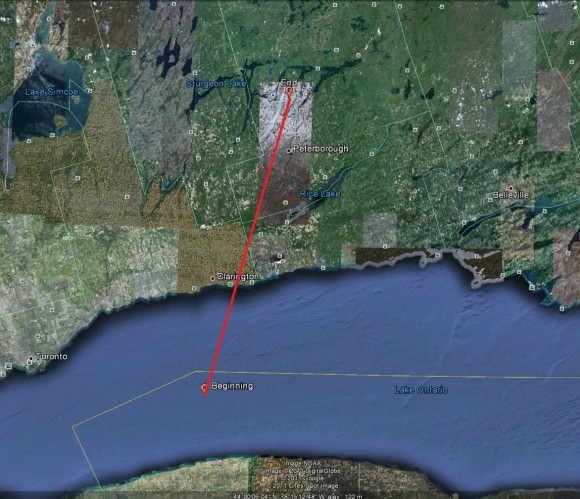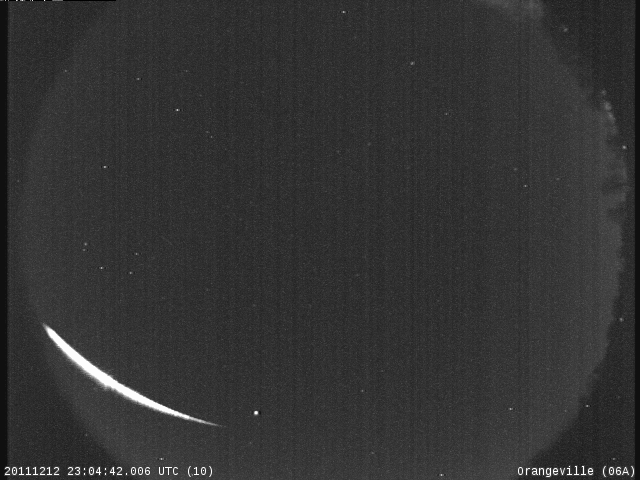[/caption]
In newly released footage from the University of Western Ontario, a bright, slow-moving fireball was captured in the skies near Toronto, Canada on December 12, 2011 by remote cameras watching for meteors. Although this meteor looks huge as it burns up in Earth’s atmosphere, astronomers estimate the rock to have been no bigger than a basketball. Footage reveals it entered the atmosphere at a shallow angle of 25 degrees, moving about 14 km per second. It first became visible over Lake Erie then moved toward the north-northeast.
See below for the video.
But in a meteorite-hunter alert, Peter Brown, the Director of Western’s Centre for Planetary & Space Exploration said that data garnered from the remote cameras suggest that surviving fragments of the rock are likely, with a mass that may total as much as a few kilograms, likely in the form of many fragments in one gram to hundreds of a gram size range.
“Finding a meteorite from a fireball captured by video is equivalent to a planetary sample return mission,” said Brown. “We know where the object comes from in our solar system and can study it in the lab. Only about a dozen previous meteorite falls have had their orbits measured by cameras so each new event adds significantly to our understanding of the small bodies in the solar system. In essence, each new recovered meteorite is adding to our understanding of the formation and evolution of our own solar system.”
Brown and his team are interested in hearing from anyone who may have witnessed or recorded this event, or who may have found fragments of the freshly fallen meteorite. See UWO’s website for contact information.
Another camera view of the meteor:
Western Meteor Group’s Southern Ontario Meteor Network sensor suite has seven all-sky video systems designed to automatically detect bright fireballs.
At 6:04 p.m. on December 12, six of the seven cameras of Western’s Southern Ontario Meteor Network recorded this meteor. In a press release, UWO said the fireball’s burned out at an altitude of 31 km just south of the town of Selwyn, Ontario. It is likely to have dropped small meteorites in a region to the east of Selwyn near the eastern end of Upper Stony Lake. See the map of the projected path below.
Although this bright fireball occurred near the peak of the annual Geminid meteor shower, the astronomers say it is unrelated to that shower.



“..first became visible over Lake Erie..” ??
I take it geography is not your strongest point. This meteor first became visible over Lake Ontario.
Check your map again … part of Lake Erie is south of Lake Ontario. Based on the angle shown in the map it is possible the flight-path was over the eastern tip of Lake Erie (just south of Buffalo NY).
“It is possible..” yes, but there is NO evidence to support that conjecture.
Look at the Google map which accompanies the article, in particular the point marked “Beginning”. If you know anyone that ‘saw’ this event over Lake Erie I will apologize but the video evidence does not support it.
Facts is facts.
Begging your pardon.
If you look at the GoogleMap accompanying the article you will note that there is NO evidence to support your conjecture. There is a point on the path that says “Beginning” and it is clearly Lake Ontario. Facts is facts.
No evidence supports this conjecture.
Glad I don’t own a cottage in the Kawarthas! Looks like everywhere from Bobcaygeon to Lakefield is in Fireball country! Hope they recover some fragments of it, but chances are Pigeon Lake swallowed it up.
It will be hard as hell to find anything in that area. Most of the countryside around Selwyn is made up of lakes, ponds and marshes. What isn’t permanently filled with water is soggy farmland (especially at this time of year) or forested. It is too bad this meteor landing couldn’t have been scheduled for mid-January, or February, when the ground would have been snow/ice covered and much easier to distinguish from a freshly landed meteorite! We’ll have to schedule the next one at a better time.